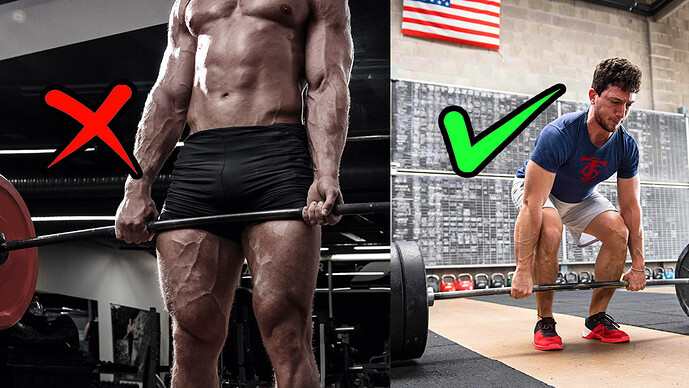01dragonslayer
Administrator
…And Some Better Options
Injuries kill workout consistency. Avoid these high-risk exercises and replace them with smart moves that are even more effective.
Dangerous Exercises: Low Benefits, High Risks
No exercise is completely risk-free, but some are riskier than others. If you’re not considering the risk-to-reward ratio, you’re failing to consider a crucial aspect of good training: making every effort to prevent injury.I never program the following exercises because the risks far outweigh the rewards, even when done with good form. Despite their popularity, none of these exercises are needed to improve your physique or performance in most sports. Sure, a couple of these must be trained if you’re a competitive powerlifter or strongman, but that’s probably not you.
1. The Heavy Mixed-Grip Deadlift

Deadlift1240×698 264 KB
Don’t use the mixed-grip deadlift when doing sets of your 6RM or heavier. The chance of biceps injury on the underhand side is just too high.
This was verified in a 2021 research paper about deadlifts and biceps tendon ruptures. (1) The researchers performed a search on YouTube using the terms “distal biceps tendon rupture” and “distal biceps tendon injury” combined with “competition,” “deadlift,” and “powerlifting.” The videos underwent an evaluation for accuracy by three surgeons.
Among the videos reviewed, 35 injuries were found appropriate for an evaluation, and 25 were observed during the deadlift. Only in one deadlift injury were both forearms in supination. In the remaining 24, injuries occurred in the mixed-grip position, with ALL the biceps ruptures occurring on the underhand (supinated) side.
This isn’t a large sample size, but when 24 of the 25 injuries are occurring with the mixed grip, the pattern is pretty predictable. The odds are stacked against lifters who use a mixed grip for heavy deads.
What To Do Instead
Use a normal, double-overhand grip. Add wrist straps if grip strength is the limiting factor.If you ARE training for a powerlifting meet, you can justify doing some mixed-grip deadlifts for your 1 to 3 RMs if that’s how you plan to lift in competition. Just know the risks and alternate supinated hands in practice.
2. The Preacher Curl with Full Elbow Extension

Preacher Curl1240×698 264 KB
I’m a huge fan of preacher curls because they strengthen the biceps in the lengthened strength zone. But I never allow people to fully straighten their elbows at the bottom of the rep, no matter how light the load. The risk of biceps injury is too high.
What To Do Instead
Don’t lower the bar or dumbbells all the way down. Keep roughly a 15-degree angle at the elbow at the bottom of each rep. Make sure you can stay in control of the weight and stop before your elbow fully straightens, even if that means lightening the load.Also, when using medium to lighter loads, don’t go to complete failure. The accumulated fatigue can also cause you to lose control of the eccentric or lowering portion of the rep.
And remember, research shows that going to complete failure isn’t needed for muscle gains. You just need to get close to failure at the end of each set (2).
3. The Tire Flip

Tire Flipping1240×698 230 KB
Tire flips, once relegated to strongman competitions, have started to turn up in boot-camp-style classes and other “functional fitness” gyms. Not good.
A study on strongman competitors found that tire flips are the most dangerous of the following events (2):

Strongman Injuries1240×698 90.8 KB
Skilled strongman competitors experienced the highest injury rates doing tire flips. If it’s risky for them, it’s even riskier for non-strongman competitors.
What To Do Instead
Tire flips are basically an awkward deadlift. So just stick with standard deadlifts, trap-bar deadlifts, and single-leg deadlifts to strengthen your posterior chain.4. The Yoke Walk

Loaded Carry1240×698 330 KB
The chart above also shows that the yoke walk is the second most dangerous strongman event. And again, yoke bars are getting more popular with average lifters and even some trainers. Having non-strongman competitors carrying a heavily loaded frame has never made sense. It doesn’t have a direct carryover to any field, court, or combat sport. And it’s a totally unnecessary risk as a general fitness exercise.
What To Do Instead
The appeal of doing strongman events? They’re cool looking and create a unique workout challenge. But if you’re looking for a way to spice up your workouts while walking with weights, there are far less risky options, like standard farmer’s walk variations 129, advanced loaded carry drills 96, and sled work 54.5. The High Box Jump

Box Jump1240×698 277 KB
I absolutely program box jumps. They’re one of the best ways to train leg power safely. What I don’t program is HIGH box jumps. They’re incredibly risky and don’t increase your ability to jump higher. High box jumps get misused when the emphasis is on the height of the box instead of the height of the actual jump.
Stand next to a high box the same height as your waist. Now pick one leg up off the ground and flex your hip as high as you possibly can. The distance between the bottom of your foot and the top of the box is the actual height you’d have to jump to get on top of that box. The rest is just hip flexion.


